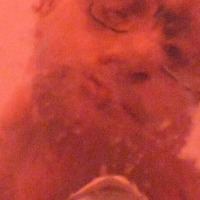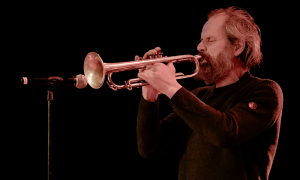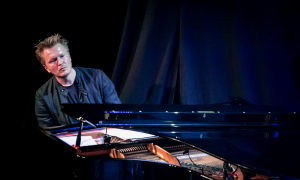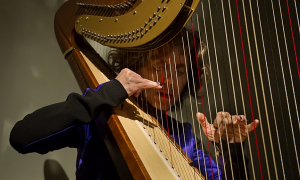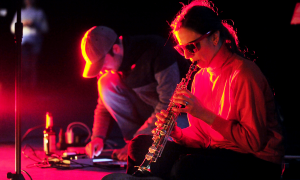Home » Jazz Articles » Festivals Talking » Moers Festival Interviews: Kenny Garrett
Moers Festival Interviews: Kenny Garrett
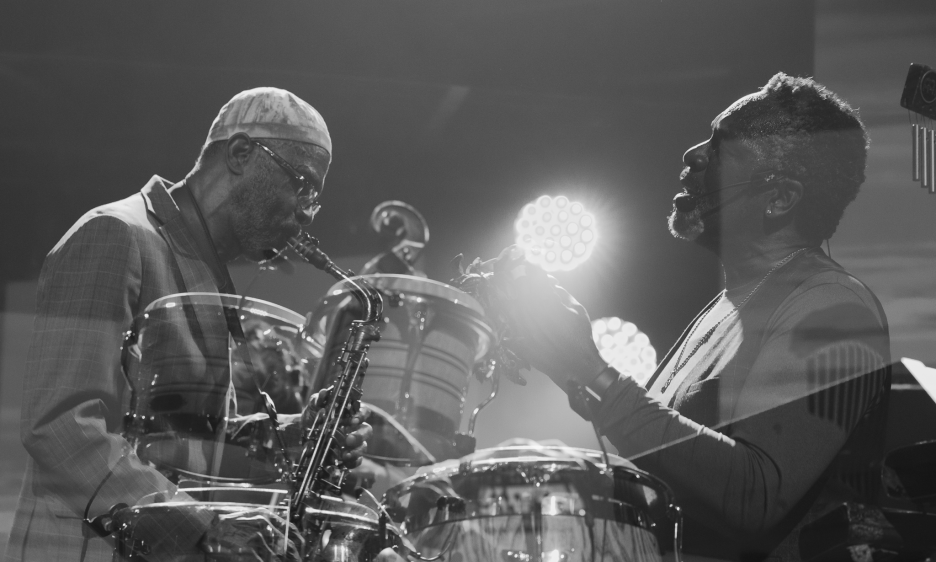
Courtesy Eve Saar
'On the eighth and final day of Jazzkaar, Garrett topped the week's bill, delivering one of this festival's finest sets. The 4 p.m. gig at Vaba Lava soon seemed like a much later party hour, Garrett relentlessly building his intensity. Much funkier than when found in a club situation, he boldly stepped up to an extroverted festival stature. The drums and percussion of Ronald Bruner and Rudy Bird drove the music hard, the latter providing agile vocal lines, closely aligned to the themes. Garrett rarely paused, continually probing new variations on winding lines, curving higher as the set's momentum gathered. The material is commercial, but still imbued with a rigorous soloing mission, all variations thoroughly investigated. A speedster trio section framed the alto, with bassman Corcoran Holt dropping out first, then Garrett left alone for an a capella saxophone stint. Bruner moved his electric fan closer, following his stupendous drum workout, and Garrett poured out a bucket full of spit following yet another epic climax.'
Kenny Garrett & Sounds From The Ancestors, Jazzkaar, Tallinn, Estonia, May 1, 2022 (Jazzwise review)
Your scribe interviewed Garrett via the old-school blower, sans video. "The concept was going back to some of the songs and the influences I heard," Garrett says of his Ancestors approach. "I've captured that, and I think it's exciting. It's the variety of the music that I heard when I was a kid. I've always been trying to integrate a lot of those experiences. You can tell, on each record, that there's a homage to some musician, one of the elders. I think that this time, what I'm doing with the music is to go back and tap into that energy I felt as a kid. I was excited about that..."
The Ancestors sound incorporates funk, jazz, gospel and Afro-Latin elements, particularly from Cuba. Garrett's current vibration is also compatible with the spiritual jazz realm, although not lying directly within that style. "There's this song, 'For Art's Sake,' it's for Art Blakey and Tony Allen, and eventually we open it up and it becomes a different song," Garrett enthuses. "It's evolving. It's one thing on the record, but when we get a chance to play it live, we can explore more, and I can start to prepare for another presentation."
Garrett has lately been gaining inspiration from the Cuban pianist Chucho Valdes. "I'm always writing from experience, and gaining, as I travel the world. What helped it along was the pandemic, because I went in the studio to record before that, the end of '18 into '19. Usually, with a record, it would have been finished, because of time constraints, but with the pandemic I had a chance to really listen to the music, and say, 'Okay, I need to add this here, I want this here, I want this there.' That's what I did, I took my time."
This was partly a case of laying down overdubs, and partly a careful tweaking of the final mix. "It turned out to be that a lot of people loved the record for its variety. Sometimes you can find a perfect response to your ideas, and [playing] live is another experience. What are you gonna do with a four-minute song? Music opens up, for sure. We're going places on tunes. If at this point I hear some beauty, and I put the beauty under the drummer, to shift it, to move someplace else, because with musicians you always have to have a place for them to move. I'll be moved too, and I start hearing things. I'm still evolving. I'm still trying different things. Let me try this here, move this here, try this..!"
When we marvel at a Garrett performance, we can trace the curve as he escalates and refines, calling upon greater and greater groove-and-testifying reserves. "I'm always trying to fine tune it, there's always something that I'm searching for, I'm always listening from a distance."
When playing live Garrett is rooted at the core, adopting a different in-the-moment strategy to that present when he's sitting at the mixing desk. Much of his onstage flame is harnessed via spontaneity, but Garrett also has elements of stability in his background, not least the familiarity of his players, several of whom he's been working with for well over a decade, and also the firmness of the supportive Mack Avenue label. "Mack Avenue is becoming a big company," says Garrett. "When I first started, it wasn't big, but now everyone's signing with them. They've been doing a great job. They're perfect for me. Plus, it has something to do with the history of Detroit. I'm from Detroit, and Mack Avenue was a very famous ice cream place."
Garrett left Detroit as a teenager, straight after high school. "I wanted to go to Berklee College Of Music, but it didn't work out for me, I don't know why, but I ended up getting an honorary doctorate from them. Instead, I graduated high school and joined the Duke Ellington Orchestra, so that was school, there..!"
This was in 1978, under the leadership of Mercer Ellington, with Garrett eventually releasing his debut solo album in 1984. "The lesson I got there was that I learned how to blend. It was one horn, not two. When I played my solos it was different. That was the concept. In the Ellington band I learned so much, I got the chance to play with Cootie Williams. I always think about the legacy of the trumpet. I liked the weight that they had in their sound. I was always trying to be one horn, with them." Garrett's talking about the collective palette of the horn sections in the Ellington band, their dedication to a group-mind expression.
Garrett has come to appreciate the way he can blend his own keyboards with the acoustic piano, on stage, but he also plays the piano on most of his albums, although he thinks that many folks don't realise this. "The piano helps me to add to the band, what I've always heard, even though conceptually. A lot of the players are playing how I hear the music, because that's the way I've taught the music."
'Kenny Garrett is in love with keyboards. This is a crush that's getting worse. Or better, depending on the listener's attitude. Not only does Garrett not play a massive amount of saxophone in this band, he has Johnny Mercer making a surging whoosh on Hammond B3 organ, and even features a briefly guesting acoustic pianist for one number. Garrett is happy seated at the Fender Rhodes electric piano, jousting with Mercer, and developing spangled lines that grow and grow in intensity. Even his alto horn has effects in place, lending it a somewhat synthy sound. Catching the final set of an Iridium residency is turning into a habit for this reviewer. It's definitely a sound plan for catching a combo at their loose-est [sic] and most confident, blowing out in style. Kona Khashu's supple electric bass omnipresence is on a woolly mammoth scale, with some of his sub-normal frequencies hitting an almost instinctive, primordial nook of the brain. Drummer Nathan Webb lashes his kit as though he's playing Senegalese sabar drums, striving for a massively thrashing freedom. Garrett is honing the funk, but it's an exercise in dirty steaming rather than any lightweight fusion-posturing.'
The Kenny Garrett Band, Iridium, NYC, October 11, 2009 (AAJ review)
Garrett can switch roles onstage, between comping and soloing, changing places with his combo's primary keyboardist. "But not [getting] in his way, so that means there's another kind of movement going on, and this is how I hear. I've been fortunate to learn a lot from the piano players that I've played with, and at the same point I try to share these ideas. That's the way that's allowed me to grow this far."
'Kenny Garrett was in funky fettle. The saxophonist's latest band seem incredibly youthful, but are also armed with impressive technique and a clear understanding of several jazz satellite forms. It didn't take Garrett long to lock into his groove. There's little fusion smoothness here. This rubbery gang of Corey Henry (Hammond organ/synths), Lenny Stallworth (electric bass) and Tim Smith (drums) started to lay down some fearsome funk, interlocked with a springy tension. The stretches where this quartet snagged onto a pneumatic riff were coiled excitement in the extreme, but then there were other passages where all became untied, and the music wandered around for a while, searching for another nexus. These are the trials of improvisation. The material was loose enough to take these risks, and the pay-off was equally extreme whichever way the music went. When he wasn't arching his alto high towards the sky, Garrett also played texturising keyboards for much of the time, setting up a Miles-ian density with Henry, whose Hammond playing exuded strength and confidence throughout.'
The Kenny Garrett Quartet, Iridium, NYC, January 9, 2008 (Spannered review)
Moers Festival is a happening for May 26-29, 2023...
All vintage review excisions penned by Martin Longley
Tags
PREVIOUS / NEXT
Kenny Garrett Concerts
Support All About Jazz
 All About Jazz has been a pillar of jazz since 1995, championing it as an art form and, more importantly, supporting the musicians who make it. Our enduring commitment has made "AAJ" one of the most culturally important websites of its kind, read by hundreds of thousands of fans, musicians and industry figures every month.
All About Jazz has been a pillar of jazz since 1995, championing it as an art form and, more importantly, supporting the musicians who make it. Our enduring commitment has made "AAJ" one of the most culturally important websites of its kind, read by hundreds of thousands of fans, musicians and industry figures every month.

